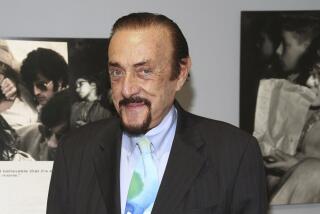Ernest Hilgard, 97; Made Hypnosis a Medical Tool
Ernest R. “Jack” Hilgard, the Stanford psychology professor who helped make hypnosis respectable as a medical tool and four decades ago led development of the Stanford Hypnotic Susceptibility Scale to standardize research practices, has died. He was 97.
Hilgard, author of several books on learning and motivation as well as hypnosis, died Oct. 22 in Palo Alto.
In 1991, the American Psychologist, the official publication of the American Psychological Assn., cited Hilgard as one of the top 10 most important psychologists of the period. In 1994, the group gave him its award for outstanding lifetime contributions to the profession.
When Hilgard won the American Psychological Foundation’s Gold Medal Award in 1978, he was cited for making “scientific contributions to nearly every field of psychology, most notably in learning and states of consciousness.”
But it was hypnosis, which Hilgard helped bring from the realm of magic and entertaining stage tricks to medicine, that garnered the most attention for the pioneering psychologist.
Studying hypnosis, Hilgard told Psychology Today in 1986, was “the most baffling and the most satisfying part of my career.”
He got into it by a circuitous route. An Illinois doctor’s son who earned a degree in chemical engineering and wrote his first scientific paper on spontaneous combustion in coal, Hilgard studied religion and philosophy at Yale Divinity School before switching to experimental psychology.
After earning a Yale doctorate, he taught there briefly and then joined the Stanford faculty in 1933. He earned accolades and intellectual standing for such books as “Conditioning and Learning” with Donald G. Marquis in 1940, “Theories of Learning” in 1948 and “Introduction to Psychology” in 1953.
He became so respected in his field that he was tapped by the Ford Foundation to head a project with the Social Science Research Council to design a comprehensive mental health program. The task seemed so daunting that many of his colleagues dubbed it “Hilgard’s Atomic Bomb.”
The assignment came with a $15-million grant, including funds for a systematic study of hypnosis. When nobody stepped forward to analyze the oft-derided discipline, Hilgard took on the task himself--with help from his wife, Stanford clinical professor of psychiatry Josephine Rohrs Hilgard.
The Hilgards established the Laboratory of Hypnosis Research at Stanford in 1957. To learn the basics of how to hypnotize and what to expect from subjects under hypnosis, Ernest Hilgard brought in a collaborator many scientists at first questioned: former stage hypnotist Andre Weitzenhoffer, who went on to earn a doctorate in psychology.
By 1959, the Hilgards and Weitzenhoffer had developed what became known as the Stanford Hypnotic Susceptibility Scale. The scale, still in use today, can help determine a person’s likelihood of being hypnotized and to what degree, providing guidance for doctors trying to use hypnosis to relieve pain or modify harmful habits such as smoking.
“While there are many unanswered questions about how hypnosis works and whom it will work for,” Hilgard told reporters at the time, “enough evidence is in to support it fully as a therapeutic tool.”
Hilgard and his wife went on to study more about the susceptibility of potential hypnosis subjects, concluding among other things that the most important factor is an ability to put aside reality temporarily and absorb oneself in fantasy, as when reading a book of fiction. They also studied the use of hypnosis in treating childhood cancer and eliminating pain during surgery.
The Hilgards wrote such books as “Hypnosis in the Relief of Pain” in 1975 and “Divided Consciousness: Multiple Controls in Human Thought and Action” in 1977.
Hilgard, former president of the International Society of Hypnosis and the American Psychological Assn., lived through and influenced so much of the development of modern psychology that he became its natural historian. In 1978, he published the book “American Psychology in Historical Perspective” and in 1987 another, “Psychology in America: A Historical Survey.” In 1988, he edited “Fifty Years of Psychology.”
Hilgard’s wife died in 1989. He is survived by a son, Henry, of Santa Cruz; a daughter, Elizabeth Jecker, of San Luis Obispo; five grandchildren; and six great-grandchildren.






